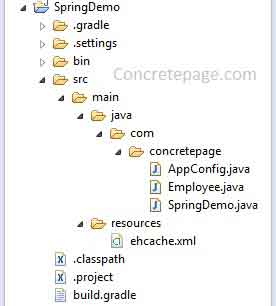Spring 4 Ehcache Configuration Example with @Cacheable Annotation
http://www.concretepage.com/spring-4/spring-4-ehcache-configuration-example-with-cacheable-annotation
Spring 4 Ehcache Configuration Example with @Cacheable Annotation
In this page, we will learn Spring 4 Ehcache configuration example with @Cacheable annotation. Ehcache manages cache for boosting performance. Spring provides @Cacheable annotation that uses cache name defined in Ehcache xml file. Spring provides EhCacheManagerFactoryBean and EhCacheCacheManager classes to configure and instantiate Ehcache. The configuration class must be annotated with @EnableCaching annotation which enables annotation driven cache management. Here we will provide a complete example for Spring Ehcache Configuration.
build.gradle
Find the Gradle file to resolve JAR dependency for Spring and Ehcache.
build.gradle
apply plugin: 'java'
apply plugin: 'eclipse'
archivesBaseName = 'concretepage'
version = '1'
repositories {
mavenCentral()
}
dependencies {
compile 'org.springframework.boot:spring-boot-starter:1.2.2.RELEASE'
compile 'org.springframework:spring-context-support:4.1.5.RELEASE'
compile 'net.sf.ehcache:ehcache-core:2.6.10'
}
Project Structure in Eclipse
Find the project structure in eclipse that will help to learn fast.

Configuration Class for EhCacheManagerFactoryBean and EhCacheCacheManager
The configuration class will be annotated with @EnableCaching annotation and we need to create bean for EhCacheManagerFactoryBean and EhCacheCacheManager class.
@EnableCaching: It enables annotation driven cache management in spring and is same as using<cache:annotation-driven />.
EhCacheManagerFactoryBean: Assign ehcache XML file by calling EhCacheManagerFactoryBean.setConfigLocation(). By passing true to setShared() method, we enable our cache to be shared as singleton at the ClassLoader level. By default it is set to false.
EhCacheCacheManager: This is a CacheManager backed by an EhCache. We can instantiate it by passing argument of EhCacheManagerFactoryBean.getObject().
Find the Configuration file.
AppConfig.java
package com.concretepage;
import org.springframework.beans.factory.annotation.Configurable;
import org.springframework.cache.CacheManager;
import org.springframework.cache.annotation.EnableCaching;
import org.springframework.cache.ehcache.EhCacheCacheManager;
import org.springframework.cache.ehcache.EhCacheManagerFactoryBean;
import org.springframework.context.annotation.Bean;
import org.springframework.core.io.ClassPathResource;
@Configurable
@EnableCaching
public class AppConfig {
@Bean
public Employee getEmployee(){
return new Employee();
}
@Bean
public CacheManager getEhCacheManager(){
return new EhCacheCacheManager(getEhCacheFactory().getObject());
}
@Bean
public EhCacheManagerFactoryBean getEhCacheFactory(){
EhCacheManagerFactoryBean factoryBean = new EhCacheManagerFactoryBean();
factoryBean.setConfigLocation(new ClassPathResource("ehcache.xml"));
factoryBean.setShared(true);
return factoryBean;
}
}
The equivalent ehcache configuration in spring xml is given below.
<cache:annotation-driven />
<bean id="employee" class="com.concretepage.Employee"/>
<bean id="cacheManager" class="org.springframework.cache.ehcache.EhCacheCacheManager"
p:cache-manager-ref="ehcache"/>
<bean id="ehcache" class="org.springframework.cache.ehcache.EhCacheManagerFactoryBean"
p:config-location="classpath:ehcache.xml" p:shared="true"/>
ehcache.xml
Find the sample ehcache.xml file. We have created a cache with the name empcache that will be used by spring @Cacheable annotation. Here maximum 5000 elements will be cached in memory and after that it will overflow to local disk. Any element will expire if it is idle for more than 200 seconds and alive for more than 500 seconds.
ehcache.xml
<?xml version="1.0" encoding="UTF-8"?>
<ehcache xmlns:xsi="http://www.w3.org/2001/XMLSchema-instance"
xsi:noNamespaceSchemaLocation="ehcache.xsd"
updateCheck="true" monitoring="autodetect" dynamicConfig="true">
<cache name="empcache"
maxEntriesLocalHeap="5000"
maxEntriesLocalDisk="1000"
eternal="false"
diskSpoolBufferSizeMB="20"
timeToIdleSeconds="200"
timeToLiveSeconds="500"
memoryStoreEvictionPolicy="LFU"
transactionalMode="off">
<persistence strategy="localTempSwap"/>
</cache>
</ehcache>
Using @Cacheable on Bean Method
If we annotate our bean method by Spring @Cacheable annotation, it declares that it will be cached. We need to provide cache name defined in ehcache.xml. In our example we have a cache named as empcache in ehcache.xml and we have provided this name in @Cacheable. Spring will hit the method for the first time. The result of this method will be cached and for same argument value, spring will not hit the method every time. Once the cache is expired, then the spring will hit the method again for the same argument value.
Employee.java
package com.concretepage;
import org.springframework.cache.annotation.Cacheable;
public class Employee {
@Cacheable("empcache")
public String getEmployee(int empId){
System.out.println("---Inside getEmployee() Method---");
if(empId==1){
return "Shankar";
}else{
return "Vishnu";
}
}
}
Test Spring Ehcache Application
Now we create a main method to test the application. Here if we call the method passing a value as an argument for the first time, spring will hit the method. And for next hit, if we pass the same argument value, we will get result from cache not by running method.
SpringDemo.java
package com.concretepage;
import org.springframework.context.annotation.AnnotationConfigApplicationContext;
public class SpringDemo {
public static void main(String... args) {
AnnotationConfigApplicationContext ctx = new AnnotationConfigApplicationContext();
ctx.register(AppConfig.class);
ctx.refresh();
Employee employee=(Employee) ctx.getBean(Employee.class); //calling getEmployee method first time.
System.out.println("---Fetch Employee with id 1---");
System.out.println("Employee:"+ employee.getEmployee(1)); //calling getEmployee method second time. This time, method will not execute.
System.out.println("---Again Fetch Employee with id 1, result will be fetched from cache---");
System.out.println("Employee:"+employee.getEmployee(1)); //calling getEmployee method third time with different value.
System.out.println("---Fetch Employee with id 2---");
System.out.println("Employee:"+employee.getEmployee(2));
}
}
Find the output.
17:06:49.301 [main] DEBUG o.s.b.f.s.DefaultListableBeanFactory - Returning cached instance of singleton bean 'getEmployee'
---Fetch Employee with id 1---
---Inside getEmployee() Method---
17:06:49.323 [main] DEBUG net.sf.ehcache.store.disk.Segment - put added 0 on heap
Employee:Shankar
---Again Fetch Employee with id 1, result will be fetched from cache---
Employee:Shankar
---Fetch Employee with id 2---
---Inside getEmployee() Method---
17:06:49.327 [main] DEBUG net.sf.ehcache.store.disk.Segment - put added 0 on heap
Employee:Vishnu
17:06:49.332 [empcache.data] DEBUG net.sf.ehcache.store.disk.Segment - fault removed 0 from heap
17:06:49.332 [empcache.data] DEBUG net.sf.ehcache.store.disk.Segment - fault added 0 on disk
Spring 4 Ehcache Configuration Example with @Cacheable Annotation的更多相关文章
- Spring整合EHCache框架
在Spring中使用缓存可以有效地避免不断地获取相同数据,重复地访问数据库,导致程序性能恶化. 在Spring中已经定义了缓存的CacheManager和Cache接口,只需要实例化便可使用. Spr ...
- Spring整合Ehcache管理缓存
前言 Ehcache 是一个成熟的缓存框架,你可以直接使用它来管理你的缓存. Spring 提供了对缓存功能的抽象:即允许绑定不同的缓存解决方案(如Ehcache),但本身不直接提供缓存功能的实现.它 ...
- Spring整合Ehcache管理缓存(转)
目录 前言 概述 安装 Ehcache的使用 HelloWorld范例 Ehcache基本操作 创建CacheManager 添加缓存 删除缓存 实现基本缓存操作 缓存配置 xml方式 API方式 S ...
- 缓存插件 Spring支持EHCache缓存
Spring仅仅是提供了对缓存的支持,但它并没有任何的缓存功能的实现,spring使用的是第三方的缓存框架来实现缓存的功能.其中,spring对EHCache提供了很好的支持. 在介绍Spring的缓 ...
- Spring整合EhCache详解
一.EhCache介绍 EhCache 是一个纯Java的进程内缓存框架,具有快速.精干等特点,是Hibernate中默认的CacheProvider.Ehcache是一种广泛使用的开 源Java分布 ...
- 以Spring整合EhCache为例从根本上了解Spring缓存这件事(转)
前两节"Spring缓存抽象"和"基于注解驱动的缓存"是为了更加清晰的了解Spring缓存机制,整合任何一个缓存实现或者叫缓存供应商都应该了解并清楚前两节,如果 ...
- spring中ehcache的配置和使用方法
继续上篇,这篇介绍服务层缓存,ehcache一般的配置和用法 一.添加jar包引用 修改pom.xml文件,加入: <dependency> <groupId>org.spri ...
- spring+shiro+ehcache整合
1.导入jar包(pom.xml文件) <!-- ehcache缓存框架 --> <dependency> <groupId>net.sf.ehcache</ ...
- Unit Testing of Spring MVC Controllers: Configuration
Original Link: http://www.petrikainulainen.net/programming/spring-framework/unit-testing-of-spring-m ...
随机推荐
- C# 中的 ref 和 out 的意义和使用方法
原文C# 中的 ref 和 out 的意义和使用方法 向方法传递一个实参时,对应的形参会用实参的一个副本来初始化,不管形参是值类型(例如 int),可空类型(int?),还是引用类型,这一点都是成立的 ...
- 【Python】linux安装tornado
想写个页面,又不想用tomcat,同事说可以用tornado,试一下 1 我从网上找了个hello world类似的程序,复制粘贴运行,提示 ImportError: No module named ...
- Jquery UI的datepicker插件使用方法
原文链接;http://www.ido321.com/375.html Jquery UI是一个非常丰富的Jquery插件,并且UI的各部分插件可以独自分离出来使用,这是其他很多Jquery插件没有的 ...
- codeforce 606C - Sorting Railway Cars
题意:给你一串数,没个数只能往前提到首位,或则往后放末尾.问最少步骤使操作后的序列成上升序列. 思路:最长连续子序列. #include<iostream> #include<std ...
- Linode各机房在中国访问速度性能测试
最近因为google的各种被X的原因,想自己弄个VPS玩玩,比来比去都推荐linode. 因为各种性能测试工具都不靠谱,还是自己机器来的直接,虽然笨拙但是真实可信. 从测试结果上看,明显东京机房的速度 ...
- dataStructure@ Check if a directed graph has cycles
#include<iostream> #include<cstdio> #include<cstring> #include<limits> #incl ...
- php透明合并png与jpg图片
源 <?php $png = imagecreatefrompng('./mark.png'); $jpeg = imagecreatefromjpeg('./image.jpg'); list ...
- [Objective-c 基础 - 2.4] 多态
A.对象的多种形态 1.父类指针指向子类对象 2.调用方法的时候,会动态监测真实地对象的方法 3.没有继承,就没有多态 4.好处:用一个父类指针可以指向不同的子类对象 5.强制转换类型之后就能使用子类 ...
- NGUI学习笔记(一):官方视频学习记录
学习NGUI一直断断续续的,目前打算做一个总结的笔记. 我使用的是比较老的3.6.0版本. 1.使用NGUI,需要开启“Edit”->“Project Settings”->“Physic ...
- html样式表极大地提高了工作效率
样式表极大地提高了工作效率 样式表定义如何显示 HTML 元素,就像 HTML 3.2 的字体标签和颜色属性所起的作用那样.样式通常保存在外部的 .css 文件中.通过仅仅编辑一个简单的 CSS 文档 ...
